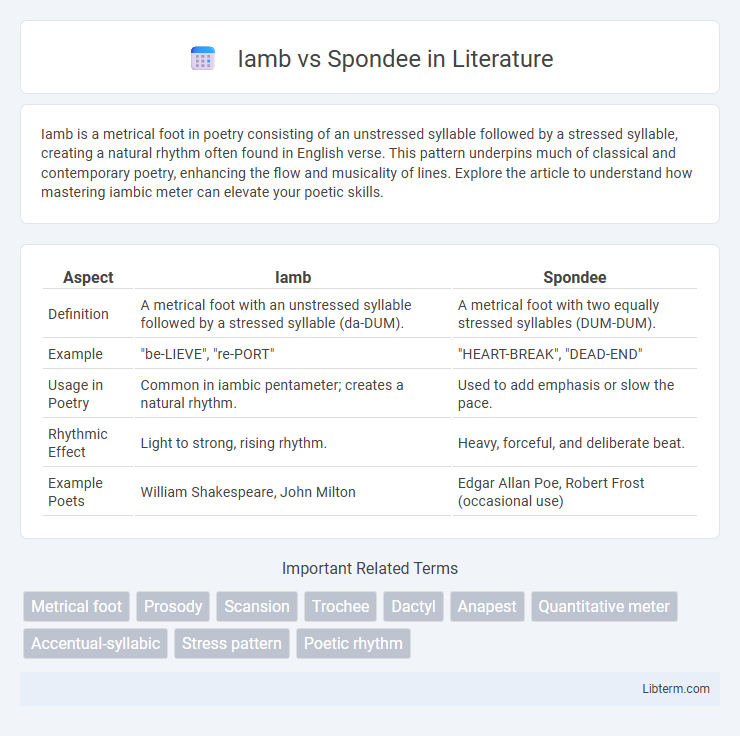Iamb is a metrical foot in poetry consisting of an unstressed syllable followed by a stressed syllable, creating a natural rhythm often found in English verse. This pattern underpins much of classical and contemporary poetry, enhancing the flow and musicality of lines. Explore the article to understand how mastering iambic meter can elevate your poetic skills.
Table of Comparison
| Aspect | Iamb | Spondee |
|---|---|---|
| Definition | A metrical foot with an unstressed syllable followed by a stressed syllable (da-DUM). | A metrical foot with two equally stressed syllables (DUM-DUM). |
| Example | "be-LIEVE", "re-PORT" | "HEART-BREAK", "DEAD-END" |
| Usage in Poetry | Common in iambic pentameter; creates a natural rhythm. | Used to add emphasis or slow the pace. |
| Rhythmic Effect | Light to strong, rising rhythm. | Heavy, forceful, and deliberate beat. |
| Example Poets | William Shakespeare, John Milton | Edgar Allan Poe, Robert Frost (occasional use) |
Understanding Iamb and Spondee: Key Definitions
Iamb and spondee are fundamental metrical feet in poetry that shape rhythm and emphasis through syllable patterns. An iamb consists of an unstressed syllable followed by a stressed syllable, such as "da-DUM," exemplified in the word "describe." In contrast, a spondee features two consecutive stressed syllables, like "DUM-DUM," creating a heavier, more emphatic beat, as seen in the compound word "heartbreak."
Historical Origins of Iamb and Spondee
The historical origins of the iamb trace back to ancient Greek and Latin poetry, where the iamb was a fundamental metrical foot consisting of an unstressed syllable followed by a stressed syllable, often used in iambic pentameter. The spondee, in contrast, originated as a metrical foot with two equally stressed syllables, frequently employed in classical epic and lyrical poetry to convey gravity and emphasis. Both metrical feet played crucial roles in shaping the rhythmic structures of Western poetic traditions.
Structural Differences Between Iamb and Spondee
Iamb and spondee differ structurally in their syllabic patterns: an iamb consists of an unstressed syllable followed by a stressed syllable, while a spondee features two equally stressed syllables. This variation in stress creates distinct rhythmic effects, with the iamb producing a rising meter commonly used in English poetry. The spondee's heavier, more forceful beat often emphasizes particular words or phrases, disrupting the regular metrical flow for dramatic impact.
The Role of Stress Patterns in Poetry
Iamb and spondee are fundamental stress patterns that shape the rhythm and mood of poetry, with iambs featuring an unstressed syllable followed by a stressed one, creating a natural, flowing beat, while spondees consist of two equally stressed syllables, producing a heavier, more forceful rhythm. The role of these metrical feet in poetry is critical for evoking emotional responses, as iambs often facilitate smooth, melodic lines, whereas spondees emphasize key words or dramatic moments. Poets strategically alternate or combine iambic and spondaic patterns to enhance meaning, control pacing, and intensify the overall impact of their verses.
Iamb: Examples in Classical and Modern Literature
An iamb is a metrical foot consisting of an unstressed syllable followed by a stressed syllable, commonly used in classical literature such as Shakespeare's "Hamlet" and modern works like Robert Frost's "Stopping by Woods on a Snowy Evening." In contrast, a spondee features two equally stressed syllables, often employed to create emphasis or a slowed rhythmic effect, as seen in phrases like "heartbreak" or "dead end." Iambic meter, especially iambic pentameter, remains a foundational rhythmic pattern that shapes the natural flow and emotional tone of English poetry across eras.
Spondee: Usage and Literary Examples
Spondees emphasize two consecutive stressed syllables, creating a heavy, deliberate rhythm that highlights important words or themes in poetry. Poets use spondees sparingly to produce a strong, emphatic effect, as seen in examples like "Break, break, break" from Alfred Lord Tennyson or the phrase "heartbreak" in various sonnets. This metrical choice disrupts typical patterns, enhancing emotional intensity and drawing attention to key moments within a verse.
Emotional Impact of Iambic and Spondaic Meter
Iambic meter, characterized by an unstressed syllable followed by a stressed syllable, creates a natural, flowing rhythm that often evokes a sense of calmness, grace, and subtle emotional buildup in poetry. Spondaic meter, with its two consecutive stressed syllables, delivers a forceful, intense, and emphatic tone, amplifying emotions like urgency, tension, or solemnity in a line. Poets strategically use iambic patterns for gentle emotional resonance, while spondaic beats emphasize moments of strong impact or dramatic emphasis.
Identifying Iambs and Spondees in Famous Poems
Iambs, characterized by an unstressed syllable followed by a stressed one, are prominently found in Shakespeare's sonnets, such as "Shall I compare thee to a summer's day," which follows a consistent iambic pentameter. Spondees, featuring two consecutive stressed syllables, create emphasis and are often used to break the rhythm, as in Edgar Allan Poe's "The Raven" with phrases like "Tell this soul with sorrow laden." Identifying these meters enhances the understanding of poetic rhythm and emotional intensity in classic literature.
How to Use Iamb and Spondee in Your Writing
Use iambs to create a natural, flowing rhythm in your writing by alternating unstressed and stressed syllables, which enhances readability and emotional impact. Spondees, consisting of two equally stressed syllables, add emphasis and weight, breaking monotony and drawing attention to key phrases or ideas. Combining iambic and spondaic meter strategically strengthens the overall cadence, balancing smoothness with intensity to engage readers effectively.
Iamb vs Spondee: Choosing the Right Meter for Your Poem
Iamb and spondee are fundamental metrical feet that shape the rhythm of poetry, with iambs consisting of an unstressed syllable followed by a stressed syllable, and spondees featuring two equally stressed syllables. Choosing between iamb and spondee meters depends on the desired tone and pacing; iambs create a natural, flowing rhythm ideal for narrative and reflective poems, while spondees produce a slow, emphatic beat that emphasizes intensity and gravity. Understanding the impact of these meters helps poets craft verses that enhance emotional resonance and reinforce thematic elements effectively.
Iamb Infographic

 libterm.com
libterm.com